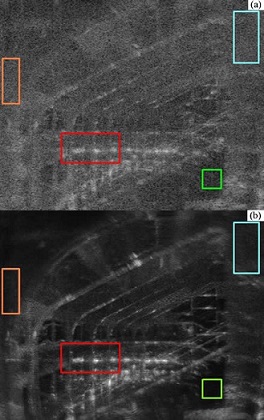The Images
Figure: Physics Building Atrium. Optical image of the atrium of the
Physics Building at Ohio State University.
Figure: Physics Building Atrium shows an optical image of the atrium of the OSU physics department. This is a considerably larger and more detailed scene than is typically used for demonstrations of millimeter-wave active images. The scale of the atrium is a length of about 50 m, a height of about 20 m and a varying width of 7-15 m. The wall on the left is curved. At the far end are open staircases and platforms with glass partitions and railings.
The upper panel of
Figure: Physics Building Atrium GHz
Image. (a)218.4 GHz image of the atrium
of the Physics Building at Ohio State Univer-
sity with multimode illumination, but without
modulated mode-mixing and (b)with modul-
ated mode mixing. The colored boxes show
areas for which speckle statistics have been
calculated.
Figure: Physics Building Atrium GHz
Image. (a)218.4 GHz image of the atrium
of the Physics Building at Ohio State Univer-
sity with multimode illumination, but without
modulated mode-mixing and (b)with modul-
ated mode mixing. The colored boxes show
areas for which speckle statistics have been
calculated.
A number of prominent features are associated with the open staircase in the far end of the atrium. From front to back are a glass front piece (topped by a metal railing), the up stairs going from right to left, a glass divider between the stairs, the up stairs going from left to right and the drywall of the atrium. While some of these features are observable in the upper panel, many more and additional detail are observable in lower panel of Figure: Physics Building Atrium GHz Image . For example, the supports of the front stairs are clearly visible (as are the turning platforms). The handrails are also observable, but not as clearly. Additionally, lighting for the atrium is provided by the reflection of light from diffuser disks suspended by wires in the volume of the atrium. These wires are more easily visible in the millimeter image than in the optical image, appearing diagonally from the lower left to the middle right portion of the image.